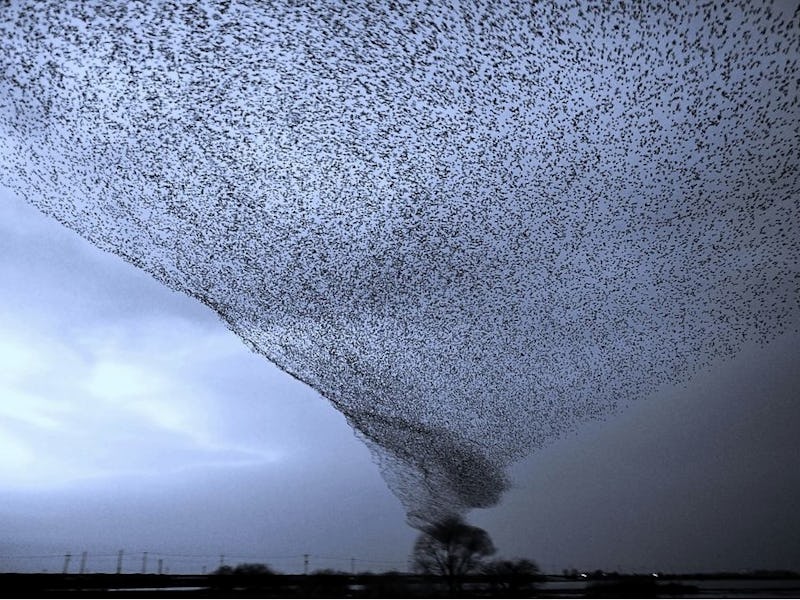Swirling Starlings Generate 'Birdnado' in Apocalyptic Reddit Photo
This isn't your average tornado.

In the school scene in Alfred Hitchcock’s terrifying 1963 classic, The Birds, a flock of black birds rapidly multiplies, steadily filling a spooky, silent playground. Imagine that, but multiply it by thousands and whip it into a swirling funnel hundreds of feet high. That’s what an intrepid photographer captured in the stormy sky over a placid countryside in an otherworldly photo posted to Reddit’s r/WTF thread this week. The photo has been dubbed by at least one user as a “birdnado.”
Unlike the premise of Sharknado, however, this is not a flock of birds unwittingly swept up into an actual tornado. Rather, it’s far more likely to be a flock of thousands of starlings flying together in a formation known as a murmuration.
Starlings, birds common to North America and Europe, are famous for forming immense flocks, sometimes containing up to 4 million individuals. Despite their otherworldly appearance, murmurations form naturally through an oddly specific organizational mechanism that scientists laid out in a 2013 PLOS Biology paper.
This "birdnado" is likely a flock of starlings forming a 'murmuration'.
Murmurations, the scientists write, are made possible by an individual starling’s ability to track the movements of exactly seven of their neighbors at any one time while flying in a flock. In the past, scientists had already determined that flock formation is beneficial for birds for a number of reasons, like easing the amount of energy required to travel and offering protection from predators. But the nature of how a flock forms — and stays together — was not clear. The team, focusing on starlings, knew that the birds had to strike a “balance between group cohesiveness and individual effort.”
The starlings in this birdnado manage to stay together because focusing on only the six or seven individuals in their immediate vicinity allows them to optimally “manage uncertainty” in highly uncertain environments. In other words, if a random disturbance causes the flock to shift suddenly, the flock will be optimally cohesive if every member pays attention to only the movements of its six or seven closest neighbors.
The birdnado may not be an actual natural disaster, but it can certainly be considered a storm — especially to the people who have to clean up the copious amounts of shit they’re known to leave behind. As Inverse reported previously in an article on murmuration, starling guano has proven to be especially hard to deal with in Rome, where they are known to pass through:
The biggest issue is that they poop everywhere, covering streets, buildings, Vespas, and trees with thick layers of foul guano. Since the starlings feast in the copious olive groves outside of Rome, their poop is also especially oily.
Fortunately, in this apocalyptic photo, the birdnado seems to be forming over some desolate-looking fields. It’s scary-looking stuff, but fortunately, it’s far less threatening than actual tornados — though the mess it leaves in its wake likely smells far worse.